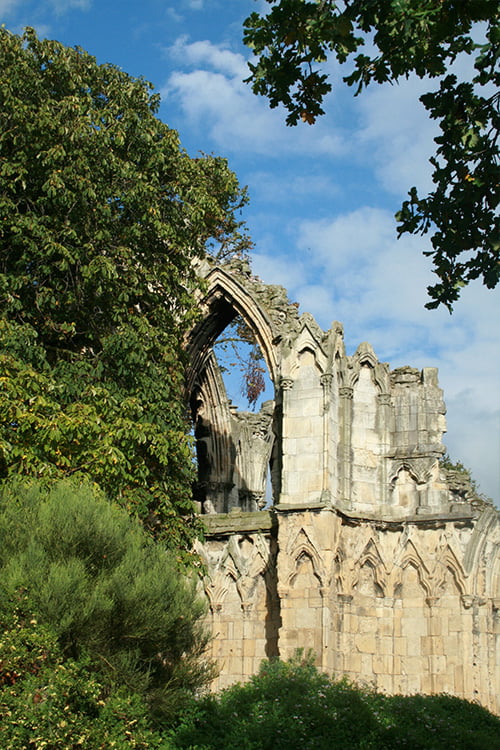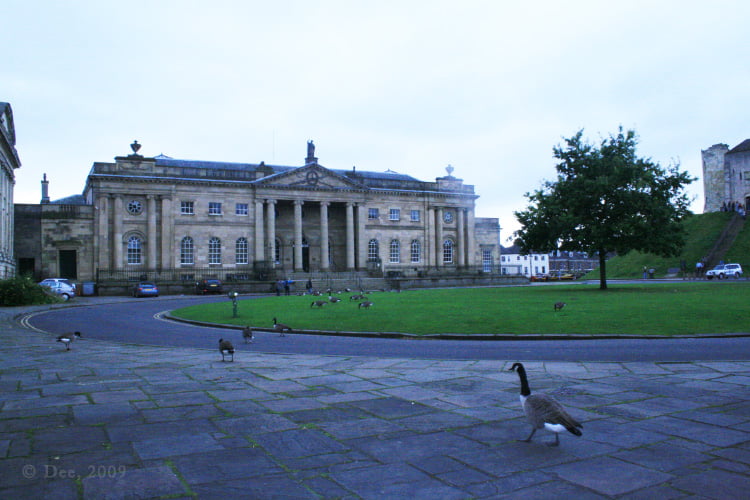I visited York yesterday and could not wait longer to write about the trip. It was such a lovely day, and I had a wonderful time. York is a fantastic city filled with archaeology and history, which was why I chose York as my destination.

York is known as a city rich with stories, starting from prehistory through medieval, my favourite period. I am going to stop there with the chronology cause information about York is aplenty. Evidence of settlements in York dates back to 8000-7000 BC with little information about them. By the time the Romans arrived, a Celtic Briton tribe called Brigantes, occupy the area. York is known as Eboracum in the Roman period. But I did not focus on the theme of the Eboracum era when I visited York this time.
I bought a ticket for a trip to York with Mbak Rini on the 17 October 2008. The cheapest return ticket available that day started very early at 7:10 am in cold and dark autumn day. I should have wanted to curl up under my duvet. But no, I got up and pulled my arse on a tram to Sheffield Station and got to York by 8:30-ish. It was a Saturday when I visited York. The city was still asleep as I got off the train and trying to figure out maps. I had York Minster in mind to see and The Shambles too, but I knew I was open for more sightseeing on that cold Saturday in York.



York Minster
As I said, I had York Minster in mind as my first stop. Mbak Rini and I had to wait until the Minster is open and we decided to walk along the old Roman walls. The colours of autumn showed up beautifully in York with leaves changing colours, and it was such a memorable experience. I’ve finally experienced the first autumn out of the tropical zone of my life. Right after getting off the train, York presented me with all shades of green, orange, brown, and yellow upon the trees and a few bunches of roses about to bloom. It was cold, yes, but it was mesmerising.
At last the Minster was opened. I could not remember if we pay a certain entrance fee or was I waving my student card and got a discount. All I know was that I was inside the beautiful church, finally. The weather was not permitting me to produce some decent photographs. I did all I could, but still, the sky isn’t as blue as I would have liked it. The history of York Minster goes back to 314 AD when a certain Bishop of York was recorded to have attended the Council of Arles (Tillott, 1961: 2).
The earlier church which then became York Minster went through a fire (741), suffered damages during the harrying of the North (1069), further damages caused by the Danes (1075), and another fire (1137) in some parts of the building. It was in 1215 when Walter de Gray was the archbishop that he ordered the Gothic style construction to match the ones in Canterbury. This part reminds me of Ken Follett’s Kingsbridge series as it tells the story of the process of building a church.
Inside, the church was even more beautiful. Now, I know my rendition of The Great West Window photograph does not do any justice to the real beauty of it. The Great West Window is a beautiful stained glass window located in the western nave of the church. This wonderfully painted window was painted by Master Robert Ketelbarn in 1338 as ordered by Archbishop Melton. The heart-shaped section on the top of the panel is known as the Heart of Yorkshire. The stained glass panels depict the archbishops of York and Christ’s apostles, along with other panels showing scenes from the life of Christ, and a panel depicting Mary as Queen. The Great West Window underwent restoration effort in 1989-1990 due to erosion.

The Great West Window
Walking through the south transept of the church, I arrived at the part called the crypt, treasury, and undercroft. This part of the church was the earliest remnants of the original Norman style architecture with carved pillars and curbed rib vaulting. Notable people buried in the Minster include Osbald of Northumbria, Tostig Godwinson of Northumbria, and earlier archbishops of the Minster. I didn’t have the chance to stay and immerse myself in the beauty of the pillar nor the effigies installed there. I had to move on through my wish list. I find that you can’t visit the Minster in one-day trip only to appreciate all chapters of its history. It would be best if you made an effort to revisit and analyse all parts of it. I had several other places to see, and I knew I had to say goodbye to the mighty York Minster.
Clifford's Tower

The next stop was Clifford’s Tower. Mbak Rini and I decided to walk from York Minster to reach the site. We went past the Guy Fawkes Inn in Low Petergate through The Shambles Market and stopped for a bit at Jorvik Viking Centre, but it was too crowded for us to get in. I hesitantly decided that I will revisit York alone and go specifically to Jorvik Viking Centre.
Not too far from the nook where Jorvik stood, I saw the rounded building of Clifford’s Tower. It’s such a weird archaeological site for me cause it stood by itself with nothing around it. It’s basically a tower on top of a mound. Of course, there is a history behind why it stands like that today.
Clifford’s Tower is the only surviving remnant of York Castle which was built in 1068 by dear William the Conqueror. The original design was motte-and-bailey castle spreading between River Ouse and River Foss. Clifford’s Tower is located on the River Foss’s side. Across Clifford’s Tower lies York Castle Museum which was opened in 1938. What’s quite strange for me is that I still don’t know why it’s called Clifford’s Tower.
One story refers to the possibility that the name might originate because Roger de Clifford was hanged there in 1322. The tower itself was known only as King’s Tower and the first recorded mention of Clifford’s Tower was not until 1596.
The story of Clifford’s Tower was highlighted by an unfortunate event in 1190 when tensions between Christians and the Jewish group in the area heightened. The situation got murkier when one Richard de Malbis (also spelt as Malebisse) incite a mob by attacking the homes of the Jewish of York. During this challenging time, the Jewish population in the city of York were given protection inside the wooden structure of the castle.
As the mob finally surrounded the castle, Rabbi Yomtob proposed an idea of collective suicide rather than falling into their hands. I’m not really clear what’s going on there, but then the castle was set on fire with some of them perished with it. Some others killed themselves and some who surrendered and promised to convert to Christianity was then also murdered. The total casualties in this event were 150 people on the Jewish side (Butler, 1997).
That’s mighty sad. I didn’t think that the history behind this sole-standing rounded ex-tower could be so grim. I seriously had a difficult time to regain my excitement of the visit after reading that placard at the bottom of the tower, right next to the stairs. You couldn’t miss it before you ascend to the top part of the tower. When I got on the top, the wind suddenly felt colder. It was really, really sad.
What’s also sad, all my photographs of Clifford’s Tower were shite. I have to admit that the pictures featured here were from my visit in the spring, hence the yellow flowers all around. There were no flowers whatsoever when I visited in autumn. So, I guess second time the lucky one?
The Ruins of St Mary's Abbey
It was afternoon when Mbak Rini and I decided to nearly call it a day. As we walked towards the rail station, we stopped at the ruins of St Mary’s Abbey. It is now located in an area known as York Museum Garden on the west side of the Minster. St Mary’s Abbey was gorgeous! I loved it.
No, wait. I apologise, I am in love with medieval architecture so yes, this one included—absolutely. St Mary’s Abbey was a Benedictine abbey built in 1055 and was dedicated to St Olaf II Haraldsson of Norway. He was King of Norway from 1015-1028 and was canonised by Pope Alexander III in 1164.
The existing ruin we see today dates back to one of its rebuilding programmes that started in 1271. The complex of St Mary’s Abbey contains remnants of the hospitium, parts of precinct walls, gatehouse, abbey church, and the abbot’s house. Some other artefacts are stored or displayed in the museum.
Other than admiring what’s left of once a magnificent architecture, there’s not much to do here. I was lucky that finally, the sky turned blue right before we decided to go back southwards to Sheffield. St Mary’s Abbey was a perfect conclusion of the day.

It was within walking distance to the rail station. We had fun but were exhausted, though only been walking in and around the old part of York. No, York cannot be a one-day visit no matter how close Sheffield is by train. I haven’t even got the chance to join one of the many of York’s ghost tours. Oh, no matter. I’ll be back—I hope so.
References
1. “Before the Norman Conquest.” A History of the County of York: the City of York. Ed. P M Tillott. London: Victoria County History, 1961. 2-24. British History Online. Web. 9 November 2020.
2. Butler, Lawrence. 1997. Clifford’s Tower and the Castles of York. London: English Heritage.


